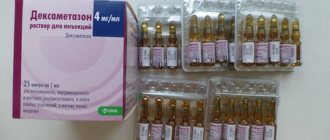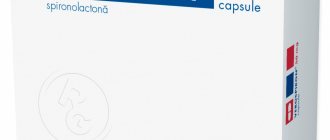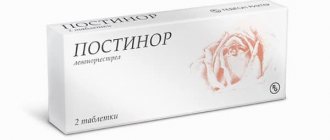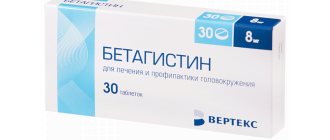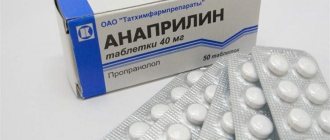Compound
The composition of the drug Sermion differs slightly depending on the amount of active substance in the composition and on the form of release of the drug.
1 tablet of Sermion contains 5 mg / 10 mg / 30 mg of the active substance nicergoline and auxiliary components: calcium hydrogen phosphate dihydrate, sodium carboxymethylcellulose, magnesium stearate, MCC. The tablet shell consists of: talc, sucrose, sandarac resin, magnesium carbonate, carnauba wax, rosin, acacia resin, titanium dioxide (E171), sunset yellow (E110).
Lyophilisate in the form of powder or white porous mass for the preparation of injection solutions. A solvent is also included - a colorless transparent liquid. Active ingredient: 4 ml of nicergoline . Excipients: tartaric acid and lactose monohydrate. Solvent composition: benzalkonium chloride, sodium chloride, water for injection (up to 4 ml).
Mode of application
Intramuscularly applied in an amount of 2-4 mg twice a day.
Intravenously: as a slow infusion of 4-8 mg in 100 ml of 0.9% sodium chloride solution or 5%-10% dextrose solution; If prescribed by a doctor, this dose can be administered several times a day.
Intra-arterial: 4 mg in 10 ml of 0.9% sodium chloride solution; Sermion is administered over 2 minutes.
The prepared solution is used immediately.
The dose and route of administration, as well as the duration of therapy, depend on the nature of the disease. Therapy can begin with parenteral administration, then switch to taking the drug orally.
Patients who have impaired renal function (serum creatinine more than 2 mg/dL) are prescribed lower therapeutic doses of Sermion.
Release form
- 5 mg tablets: convex round tablets with an orange coating in blisters of 15 pcs. A cardboard pack contains 2 blisters.
- 10 mg tablets: convex round tablets with a white coating in blisters of 25 pcs. A cardboard pack contains 2 blisters.
- Tablets 30 mg: biconvex round tablets with a yellow coating in blisters of 15 pcs. A cardboard pack contains 2 blisters.
- The lyophilisate for the preparation of injection solutions is contained in colorless glass bottles. Also included are ampoules with solvent. One cardboard box contains 4 bottles of lyophilisate and 4 ampoules with solvent.
pharmachologic effect
The medicine improves peripheral and cerebral circulation, and is also an alpha-blocker. The main active ingredient of the drug nicergoline is a derivative of ergoline and improves hemodynamic and metabolic processes occurring in the brain.
The drug reduces platelet aggregation and also improves blood rheology; in addition, it accelerates blood flow in the lower and upper extremities. The improvement in blood flow is due to the alpha 1-adrenergic blocking effect.
Sermion directly affects the cerebral neurotransmitter systems - dopaminergic, noradrenergic and acetylcholinergic, which has a beneficial effect on cognitive processes. With long-term use of the drug, patients experienced a decrease in the severity of behavioral disorders associated with dementia, and the cognitive function of the body also improved.
Pharmacodynamics and pharmacokinetics
Absorption (for tablets)
Once in the human body, nicergoline is absorbed very quickly and with virtually no residue. The rate and degree of absorption of nicergoline practically does not depend on either the dosage form or food intake. When using a dosage of up to 60 mg, the pharmacokinetics of nicergoline is linear, without changing depending on the age of the drug taker.
Distribution and metabolism
The substance nicergoline binds more than 90% to plasma proteins, while the degree of its affinity for serum albumin is less than for the α-acid of the glycoprotein. Nicergoline, as well as its metabolites, can be distributed in blood cells.
The main metabolic products of the substance nicergoline are: 6-methyl-8β-hydroxymethyl-10α-methoxyergoline (MDL, the result of demethylation occurring under the action of the CYP2D6 isoenzyme) and 1,6-dimethyl-8β-hydroxymethyl-10α-methoxyergoline (MMDL, a product formed as a result of hydrolysis).
When nicergoline is administered intravenously or taken orally, the ratio of AUC values for MDL and MMDL indicates apparent first-pass metabolism through the liver. With 30 mg of the drug, Cmax MMDL (21 ± 14 ng/ml) and MDL (41 ± 14 ng/ml) were achieved after 1 and 4 hours, respectively, after which the concentration of MDL decreased with a half-life of 13-20 hours. The studies also confirmed the absence of accumulation of other metabolites in the blood (including MMDL).
Removal
The substance nicergoline is excreted from the body in the form of metabolites , mostly in the urine (about 80%), as well as in feces (about 10-20% of the total dose).
Pharmacokinetics manifested in special clinical cases
Those patients who suffered from severe renal failure
Pharmacological properties of the drug Sermion
Pharmacodynamics. After oral administration, it is quickly and extensively metabolized to form a number of metabolites, which also have an effect at various levels of the central nervous system. Sermion has a positive effect on the emotional state, ability to concentrate and level of vigor. After oral administration, Sermion causes various neuropharmacological effects: it not only increases glucose consumption by brain tissue, enhances the biosynthesis of proteins and nucleic acids, but also affects various neurotransmitter systems. Increased choline acetyltransferase activity and muscarinic receptor density were also observed after prolonged oral administration of Sermion. In addition, in both in vitro and in vivo , nicergoline significantly increased acetylcholinesterase activity. Both after single and long-term oral administration of the drug, the exchange of basal and agonist-sensitive phosphoinositide increases. Sermion also enhances the activity and translocation of Ca-dependent PKC isoforms across the membrane. These enzymes are involved in the mechanism of secretion of soluble amyloid precursor protein, which leads to increased release and decreased production of pathological beta-amyloid, as demonstrated in cultured human neuroblastoma. The antioxidant effect and activation of detoxification enzymes by Sermion protects nerve cells from death due to oxidative stress and apoptosis in experimental models in vivo and in vitro . Sermion attenuates the age-dependent decline in nitric oxide synthetase mRNA in neurons, which improves cognitive function. Pharmacokinetics. Nicergoline is rapidly and almost completely absorbed after oral administration. The peak of serum radioactivity after administration of low doses (4–5 mg) of radiolabeled nicergoline was observed after 1.5 hours. However, with oral administration of therapeutic x doses (30 mg) of 3H-labeled nicergoline, the peak of serum radioactivity in the blood serum was observed after 3 hours. The half-life of the drug is approximately 15 hours (healthy volunteers). The absolute bioavailability of nicergoline after oral administration is approximately 5%, due to high hepatic clearance and first-pass metabolism. After oral administration of nicergoline at therapeutic doses, the AUC values in radioactive serum were 81 and 6%, respectively, for the main metabolites MDL and MMDL (healthy volunteers). Peak plasma concentrations of MDL and MMDL were achieved approximately 1 and 4 hours after dosing with a half-life of 13 and 14 hours. Nicergoline is rapidly hydrolyzed due to binding with esters after intravenous administration. The drug is quickly and extensively distributed in tissues. The volume of distribution of nicergoline was 105 L, which likely reflects the metabolism of the drug in the blood and its penetration into blood cells and/or tissues. Nicergoline binds extensively to plasma proteins (90%), with greater affinity for α-acid glycoprotein than for serum albumin. Urinary excretion is the main route of excretion, since 80% of the total dose of radiolabeled nicergoline is determined in urine and only 10–20% in feces. When administered orally in doses of 30–60 mg, it has been established that the pharmacokinetics of nicergoline is linear. Nicergoline is extensively metabolized before elimination. The main route of metabolism is hydrolysis of ester bonds to form the metabolite MMDL. The following biotransformation leads to the formation of the metabolite MDL by demethylation. The demethylation process occurs with the participation of the catalytic action of the CYP 2D6 isoenzyme. The metabolite MDL is mainly formed, accounting for 50% of the total dose and 74% of the radioactivity detected in urine. As a secondary metabolic pathway, 1-dimethylnicergoline is formed by demethylation (1-DN) and then metabolized by hydrolysis of ester bonds into MDL. In patients with severe renal impairment, there is a significant reduction in urinary MDL secretion.
Indications for use of Sermion
The drug is indicated for:
- chronic and acute cerebral vascular and metabolic disorders (occurring as a result of arterial hypertension , atherosclerosis , embolism or thrombosis of cerebral , including vascular dementia , acute transient cerebral circulatory disorder, as well as headache caused by vasospasm );
- chronic and acute vascular and metabolic disorders (functional and organic arteriopathy of the extremities , syndromes that manifest themselves as a result of impaired peripheral blood flow, as well as Raynaud's disease );
- as an additional remedy during the treatment of hypertensive crisis .
Indications
Sermion can be used for therapy in cases of acute and chronic cerebral metabolic and vascular disorders arising from atherosclerosis (in particular, dyscirculatory encephalopathy), high blood pressure, thrombosis or embolism of cerebral vessels (vascular dementia, transient cerebral attack, headache caused by vasospasm ).
It is used for acute and chronic peripheral metabolic and vascular disorders (Raynaud's disease, as well as organic and functional arteriopathy of the extremities, and syndromes associated with disturbances of peripheral blood flow).
As an additional treatment for hypertensive crises (parenteral use).
Contraindications
The drug is contraindicated in:
- violation of orthostatic regulation;
- recent myocardial infarction ;
- severe bradycardia ;
- acute bleeding;
- hypersensitivity to those substances contained in the drug.
The drug should be taken with caution if there is a history of gout or hyperuricemia and/or if the drug must be combined with drugs that interfere with the excretion of uric acid and/or metabolism.
In addition to the above, indications for the use of Sermion tablets have additional restrictions:
- the patient's age is under 18 years;
- periods of pregnancy and lactation;
- deficiency in the body of isomaltase/sucrase, glucose-galactose malabsorption, as well as fructose intolerance.
Side effects
For the nervous system: insomnia or drowsiness occasionally occurs.
For the cardiovascular system: occasionally there is a pronounced decrease in blood pressure (especially with parenteral administration of the drug), fever, dizziness.
For metabolism: an increase in the concentration of uric acid in the blood may occur. This effect does not depend on dosage or duration of treatment.
Other side effects: skin rashes and dyspeptic symptoms occur occasionally.
As a rule, the side effects of the drug are moderate.
Side effects of the drug Sermion
The following non-severe side effects have been reported rarely. From the gastrointestinal tract: constipation, nausea, vomiting, increased acidity of gastric juice, diarrhea, abdominal pain. From the cardiovascular system: arterial hypotension, dizziness, angina attacks, cold extremities, tachycardia. From the side of the central nervous system: dizziness, headache, confusion, drowsiness, insomnia. Allergic reactions: angioedema, itching, skin rash. Reproductive disorders in men: ejaculation disorders. General disorders: feeling of heat, hot flashes, sweating, pain in the limbs, increased body temperature. During clinical studies, an increase in uric acid levels in the blood was observed, which was independent of both the dose used and the duration of treatment.
Instructions for use of Sermion (Method and dosage)
Sermion tablets
The drug is prescribed orally.
For post-stroke conditions, cognitive vascular disorders and chronic cerebral circulatory disorders, Sermion tablets should be taken three times a day, 10 mg. The minimum course of treatment is 3 months, since the therapeutic effect of the drug appears gradually.
For vascular dementia, the medicine Sermion should be taken twice a day, 30 mg. It is recommended to consult with your doctor every 6 months to determine the advisability of continuing the course of treatment.
For ischemic stroke caused by thrombosis , atherosclerosis and embolism of cerebral vessels, acute as well as transient cerebral circulatory disorders (with hypertensive cerebral crises and transistor ischemic attacks ) - the course of treatment is best started with parenteral administration of the drug Nicergoline , after which Sermion is taken orally.
For peripheral circulatory disorders, the medicine should be taken three times a day, 10 mg at a time, for a long time (several months).
Patients who have impaired renal function (serum creatinine level exceeds 2 mg/dL) should take Sermion at a lower therapeutic dosage.
Instructions for use of Sermion lyophilisate
Intramuscularly: 2-4 ml of the drug is administered twice a day (2-4 mg).
Intravenously: the drug is administered slowly at a dosage of 4-8 mg in 100 ml of 5-10% dextrose solution or 0.9% sodium chloride solution. At this dosage, injections with the drug can be given up to several times a day.
sodium chloride solution is injected within 2 minutes .
It is recommended to use the reconstituted solution immediately after preparation.
The duration of therapy, dosage, and method of administration of the drug into the body depend on the disease. Sometimes it is better to start treatment with parenteral administration of the drug, and then switch to oral administration for the purpose of maintenance treatment.
Patients who have impaired renal function (serum creatinine level exceeds 2 mg/dL) Sermion should be taken at a lower therapeutic dosage.
Instructions for use SERMION
Nicergoline is an ergoline derivative that has an alpha1-adrenergic blocking effect. After oral administration, nicergoline is rapidly and extensively metabolized to form a number of metabolites, which also have effects at various levels of the central nervous system.
After oral administration, Sermion has various neuropharmacological effects, since it not only stimulates the uptake and subsequent utilization of glucose by brain tissue, enhances the biosynthesis of proteins and nucleic acids, but also affects various neurotransmitter systems.
Sermion improved the functioning of the cholinergic systems of the brain in elderly animals. Chronic administration of Sermion to elderly rats reversed the age-related decrease in acetylcholine levels (in the cerebral cortex and striatum) as well as the decrease in acetylcholine release (in the hippocampus) in vivo. After prolonged oral administration of Sermion, an increase in choline acetyltransferase activity and an increase in the density of muscarinic receptors were also observed. In addition, in both in vitro and in vivo experiments, nicergoline significantly increased acetylcholinesterase activity. In these experiments, parallel dynamics of neurochemical changes and persistent improvements in behavioral reactions were noted. For example, in a maze study, mature animals chronically treated with Sermion developed a response similar to that of young animals.
It was found that Sermion improves the state of the cognitive sphere in cases of cognitive deficiency caused by various factors (hypoxia, electroconvulsive therapy, scopolamine). When Sermion was taken orally in low doses, activation of dopamine metabolism was noted in elderly animals, especially in the mesolimbic region, which is probably due to the effect on dopaminergic receptors. Sermion improved the mechanisms of signal transduction in cells in elderly animals. Both after single and long-term oral administration of the drug, basal and agonist-sensitive phosphoinositide metabolism increased. Sermion also stimulates the activity and translocation through the cell membrane of calcium-dependent isoforms of protein kinase C. These enzymes participate in the mechanism of secretion of soluble APP (amyloid precursor protein), which leads to an increase in its release and a decrease in the production of pathological beta-amyloid, which has been demonstrated in culture human neuroblastoma.
Due to the antioxidant effect and activation of detoxification enzymes, Sermion protected nerve cells from death caused by oxidative stress and apoptosis in experimental models in vivo and in vitro. Sermion attenuates the age-related decline in NO synthase (nNOS) mRNA in neurons, which improves cognitive function.
Pharmacodynamics studies in humans
Pharmacodynamics were assessed in young and elderly healthy volunteers, as well as in elderly patients with cognitive impairment using computerized EEG. Sermion had a normalizing effect on the EEG of elderly patients and adults after hypoxia, which was manifested in an increase in α- and β-activity and a decrease in δ- and θ-activity. With long-term use of Sermion (for 2-6 months), positive changes were noted in the parameters of evoked response potentials in patients with mild to moderate dementia of various etiologies (senile dementia of the Alzheimer's type and mild intellectual disability), these changes correlated with improvement in clinical symptoms.
Based on the above, it is clear that nicergoline has broad modulatory effects on the cellular and molecular mechanisms involved in the pathophysiology of dementia.
In double-blind, placebo-controlled clinical trials, more than 1500 patients with dementia (Alzheimer's, vascular and mixed type) received nicergoline 60 mg/day or placebo. Improvements in dementia-related cognitive function and behavior have been observed following long-term use of nicergoline. Positive dynamics were observed after 2 months of treatment and the improvements achieved during therapy were maintained for one year.
Sermion reduces platelet aggregation and improves hemorheological parameters of the blood, increases the speed of blood flow in the upper and lower extremities.
Interaction
Taking Sermion together with anticholinergic and antihypertensive drugs, the effect of the latter can be enhanced.
If you take the drug simultaneously with cholestyramine or non-absorbable antacids, the absorption of Sermion occurs more slowly.
The drug is metabolized with the direct participation of the CYP 2D6 enzyme, so it may interact with other drugs that are also biotransformed with the help of this enzyme ( Risperidone , Rinidine , and other antipsychotics).
Interactions of the drug Sermion drug Sermion
The drug should be used with caution in combination with:
- antihypertensive drugs (nicergoline may potentiate their effects);
- drugs that are also metabolized by the cytochrome CYP 2D6 system, since it is impossible to exclude interaction with these drugs (such as quinidine, most antipsychotics, including clozapine, risperidone, haloperidol, thioridazine);
- acetylsalicylic acid (bleeding time may prolong);
- drugs that affect the metabolism of uric acid (metabolism and excretion of uric acid may change).
Sermion should not be used simultaneously with drugs that excite the central nervous system, α- and β-adrenergic agonists. When used simultaneously with anticoagulant and antiplatelet agents, it is necessary to monitor the indicators of the lightening blood system. The drug may enhance the effects of cholinomimetic drugs.
special instructions
Typically, Sermion, used in therapeutic doses, has no effect on blood pressure. However, those patients who have arterial hypertension may experience a gradual decrease in blood pressure caused by the action of the drug.
If the drug is administered parenterally, patients are advised to lie down for a few minutes immediately after the injection, because arterial hypotension . This is especially true for those patients who have just started treatment with the drug.
The effect of the drug manifests itself gradually, so Sermion must be taken for a long time. Throughout the course of treatment, the doctor must periodically assess the effect of treatment, as well as the advisability of continuing treatment in the future.
The effect on the ability to operate machinery and drive vehicles has not been studied. Therefore, despite the ability of the drug to improve concentration, patients are advised to exercise extreme caution when driving or operating machinery, especially given the nature of the underlying disease.
Special instructions for the use of the drug Sermion
As a rule, Sermion in recommended therapeutic doses does not cause changes in blood pressure levels, however, in patients prone to hypertension (arterial hypertension), the drug can gradually reduce blood pressure levels. At the beginning of treatment, orthostatic hypotension may develop. For the treatment of patients with a history of hyperuricemia or gout and/or during concomitant treatment with drugs that affect the metabolism and excretion of uric acid, Sermion is prescribed with caution. Since approximately 80% of nicergoline metabolites are excreted in the urine, it is recommended to reduce the dose of the drug in patients with impaired renal function (serum creatinine 2 mg/dL or 175 mmol/L). The drug contains lactose, which must be taken into account when prescribing it to patients with congenital lactase deficiency, hereditary galactosemia and impaired absorption of glucose and galactose. The effect of using the drug develops gradually, so Sermion should be taken for a long time. It is advisable to evaluate the effect of therapy every 6 months to decide on the advisability of further use of the drug. While using the drug, you should refrain from drinking alcohol. Children. The drug is not used in children. Use during pregnancy and lactation. Toxicological studies have not demonstrated the teratogenic effect of nicergoline. Based on the indications, the use of the drug during pregnancy and breastfeeding is unlikely. If there are solid indications, the drug should be prescribed after considering the ratio of benefit to the mother/risk to the fetus (child). The ability to influence the reaction rate when driving a vehicle or while working with other mechanisms. Although the clinical effects of Sermion are used to improve concentration, its effect on the ability to drive vehicles and operate potentially dangerous machinery has not been studied. During treatment with the drug, and also taking into account the underlying disease, patients should be careful when driving vehicles or operating other mechanisms.
Reviews about Sermione
You can find a lot of reviews about the drug Sermion on the Internet, and almost all of them are positive. Patients taking the drug report its high effectiveness. Their blood pressure was normalized, the number of migraine attacks gradually decreased, and their headaches stopped hurting. Many reviews about Sermion contain patient reports of increased concentration and improved cognitive functions of the body.
The forum also contains warnings to patients who have taken the pills that this medicine should be taken for a long time, since it only begins to work as it accumulates in the body. In this regard, there were a few patient reviews about Sermion in a negative context - those who took the drug, without seeing the effect, quit the course of treatment.
There are also warnings that this drug is not suitable for children. It should not be taken by children and adolescents under 18 years of age.
Sermion price, where to buy
Depending on the markup of pharmacies and the form of release of the drug, the price of Sermion tablets can vary greatly:
- 5 mg tablets cost about 550 rubles for 30 pieces. packaged;
- 10 mg tablets can be found at a price of about 700 rubles per package containing 50 tablets;
- the cost of 30 mg tablets is about 1200 rubles per pack of 30 pcs.;
- the price of Sermion in ampoules is about 2100 rubles per package.
- Online pharmacies in RussiaRussia
- Online pharmacies in UkraineUkraine
- Online pharmacies in KazakhstanKazakhstan
ZdravCity
- Sermion tablets p.p.o.
5mg 30 pcs Phizer Italia Srl RUR 522 order - Sermion tablets p.p.o. 30 mg 30 pcs. Pfizer Italy S.r.L.
RUB 1,276 order
Pharmacy Dialogue
- Sermion (5 mg tablet No. 30)Pfizer Italia SrL
RUR 569 order
- Sermion (tab. 30 mg No. 30) Pfizer
RUB 1,234 order
- Sermion (tab. 10 mg No. 50) Pfizer Italia SrL
RUR 664 order
- Sermion (tab. 10 mg No. 50) Pfizer
RUR 713 order
- Sermion (amp. 4 mg No. 4 + solution) Actavis
RUB 2,311 order
show more
Pharmacy24
- Sermion 30 mg N30 tablets Pfizer Italy S.r.l., Italy
391 UAH.order - Sermion 10 mg N50 tablets Pfizer Italy S.r.l., Italy
310 UAH. order
- Sermion 4 mg 4 ml N4 powder Actavis Italy S.p.A., Italy
1101 UAH. order
- Sermion 5 mg No. 30 tablets Pfizer Italy S.r.l., Italy
203 UAH order
PaniPharmacy
- Sermion tablets Sermion tablets. 10 mg No. 50 Italy, Pfizer Italia
302 UAH. order
- Sermion tablets Sermion tablets. 5mg No. 30 Italy, Pfizer Italia
207 UAH. order
- Sermion ampoule Sermion lyophilized powder for injection 4 mg No. 4 Italy, Actavis Italia
1164 UAH. order
- Sermion tablets Sermion tablets. 30 mg No. 30 Italy, Pfizer Italia
392 UAH. order
show more
Use of the drug Sermion
5 mg tablets: the recommended dose of the drug is 5–10 mg 3 times a day with equal intervals between doses for a long period of time. Dosage, duration and route of administration of the drug depend on the specific clinical situation. In some cases, it is advisable to begin treatment with parenteral administration of the drug with further continuation of treatment in the form of maintenance oral therapy. 30 mg tablets: the recommended dose of the drug is 1 tablet 1-2 times a day (30-60 mg). The usual daily dose for adults is 30 mg. Temporarily the daily dose can be increased to 60 mg. In case of vascular disorders of the eye or inner ear, the recommended dose is 30 mg per day. The drug should be taken before meals with a small amount of water, without chewing. If the dose is prescribed once a day, it is advisable to take the drug in the morning. Since renal excretion is the main route of elimination (80%) of nicergoline and its metabolites, it is recommended to reduce the dose in patients with impaired renal function (serum creatinine ≤20%). solution for injection : the drug is intended for parenteral use. For intramuscular administration, the recommended dose is 2–4 mg (2–4 ml) 2 times a day (using the supplied solvent). For intravenous administration, the recommended dose of Sermion is 4–8 mg, having previously dissolved it in 100 ml of 0.9% sodium chloride solution or 5% dextrose (glucose) solution. The drug should be administered intravenously slowly. At the doctor's discretion, this dose may be repeated throughout the day. If necessary, Sermion can be administered intra-arterially at a dose of 4 mg in 10 ml of 0.9% sodium chloride solution, slowly, over at least 2 minutes. The dose, duration of treatment and route of administration are determined by the doctor individually.
